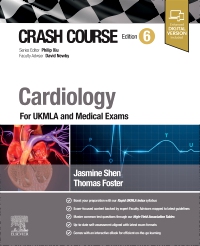
Crash Course Cardiology, 6th Edition
Paperback

Now $38.12
Crash Course – your effective every-day study companion PLUS the perfect antidote for exam stress! Save time and be assured you have the essential information you need in one place to excel on your course and achieve exam success.
A winning formula now for over 25 years, having sold over 1 million copies and translated in over 8 languages, each series volume has been fine-tuned and fully updated with a full-colour layout tailored to make your life easier. Especially written by senior students or junior doctors – those who understand what is essential for exam success – with all information thoroughly checked and quality assured by expert Faculty Advisers, the result is books that exactly meet your needs and you know you can trust.
Each chapter guides you succinctly through the full range of curriculum topics in the UKMLA syllabus, integrating clinical considerations with the relevant basic science and avoiding unnecessary or confusing detail. A range of text boxes help you get to the hints, tips and key points you need fast! A fully revised self-assessment section matching the latest exam formats is included to check your understanding and aid exam preparation. The accompanying enhanced, downloadable eBook completes this invaluable learning package.
Series volumes have been honed to meet the requirements of today’s medical students, although the range of other health students and professionals who need rapid access to the essentials of cardiology will also love the unique approach of Crash Course. Whether you need to get out of a fix or aim for a distinction Crash Course is for you!
Crash Course Cardiology: For UKMLA and Medical Exams, Sixth Edition comprehensively covers cardiology in the medical curriculum, integrating new developments and treatment guidelines. Notably, heart failure management and new guidelines on hypertension, DVLA driving, and adult life support/resuscitation have been incorporated into the content. A new chapter on vascular disease has been introduced, covering aortic, pulmonary, mesenteric, and peripheral vascular conditions, acknowledging their overlap with cardiac disease presentations
-
- Fully aligned to UKMLA requirements, with key ‘conditions’ and ‘presentations’ highlighted in handy checklists - save valuable revision time and be confident you have the syllabus covered
- Written by senior students and recent graduates - those closest to what is essential for exam success
- Quality assured by leading Faculty Advisors - ensures complete accuracy of information
- Features the ever popular 'Hints and Tips' boxes and other useful aide-mémoires - distilled wisdom from those in the know
- Updated self-assessment section matching the latest exam formats – confirm your understanding and improve exam technique fast
-
Section 1: The basics
1. Cardiac anatomy, physiology and development
Why do we need a cardiovascular system?
Anatomy of the heart and great vessels
Development of the heart and great vessels
2. The cardiac cycle, control of cardiac output and haemodynamic regulation
Cardiac electrophysiology
The cardiac cycle
Control of cardiac output
Haemodynamics and vascular function
Integrated control of the cardiovascular system and cardiovascular reflexes
3. ECG interpretation
The electrocardiogram
Presenting an ECG
4. Other cardiac investigations
Common cardiac blood tests
Exercise ECG
Echocardiography
Computed tomography coronary angiography
Cardiac magnetic resonance
Cardiac catheterization
Radionuclide imaging
Section 2: Presenting complaints
5. History and examination of the cardiovascular system
History
Clinical examination
Cardiovascular examination summary
6. Chest pain
Differential diagnosis
History
Examination
Investigations
New onset central chest pain at rest in an ill patient
7. Breathlessness and peripheral oedema
Differential diagnosis
History
Examination
Investigation
Recent onset dyspnoea at rest in an ill patient
8. Palpitations
Differential diagnosis
History
Examination
Investigations
Palpitations in the unwell patient
9. Syncope
Differential diagnosis of syncope
History
Examination
Investigations
Reflex (neurally mediated) syncope
Syncope of recent onset in the unwell patient
Driving regulations in syncopal patients
10. Heart murmurs
Differential diagnosis
History
Examination
Investigations
Presenting your findings
Section 3: Clinical conditions
11. Atherosclerosis and its risk factors
Pathogenesis of atherosclerosis
Classification of ischaemic heart disease
Risk factors for atherosclerosis
Risk prediction and primary prevention of ischaemic heart disease
Lipids and the cardiovascular system
Hypertension
12. Stable angina and acute coronary syndromes
Stable angina
Acute coronary syndromes
13. Heart failure
Pathophysiology of heart failure
Clinical features
Investigations
Management
14. Arrhythmias
Bradyarrhythmias
Supraventricular tachyarrhythmias
Ventricular arrhythmias
Antiarrhythmic drugs
Algorithms for management of arrhythmias
Cardiac arrest and resuscitation
15. Valvular disease
Rheumatic heart disease
Aortic stenosis
Aortic regurgitation
Mitral stenosis
Mitral regurgitation
Tricuspid disease
Pulmonary disease
Assessing the severity of a valve lesion
Prosthetic heart valves
Infective endocarditis
16. Diseases of the myocardium and pericardium
Diseases of the myocardium
Diseases of the pericardium
17. Congenital heart disease
Causes of congenital heart disease
Complications of congenital heart disease
Pregnancy risk assessment
Congenital defects with left-to-right shunts
Congenital defects with right-to-left shunts
Obstructive congenital defects
Other lesions in congenital heart disease
18. Vascular disease
Arterial disease
Venous disease
Self-Assessment
UKMLA High Yield Association Table
UKMLA Single Best Answer (SBA) Questions
UKMLA SBA Answers
OSCEs and Short Clinical Cases

 as described in our
as described in our 